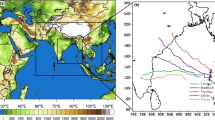Summary
The University of Belgrade/National Meteorological Centre, Washington (UB/NMC) limited area Eta Model predicted the development, structure, associated precipitation and tracks of the Australian Monsoon Experiment (AMEX) (10 January through 15 February 1987) tropical cyclonesConnie, Irma, Damien andJason. The initial positions and intensities of the tropical cyclone vortices from the global European Centre for Medium-Range Weather Forecasts (ECMWF) analyses, which are used as initial data, do not quite agree with the observations. These disagreements produce additional erros in predicting the tropical cyclone tracks.
To improve the initial position of the vortex, the flow is split into the small and the large scale motions, and during the first two hours of the integration, the small-scale part is forced in small steps towards its observed position. The adjustment is performaed with the reduced model dynamics (adjustment processes only) and no physics.
With the adjustment during the first two hours of the integration, the model successfully adjusts to the new position of the initial vortex. After the completion of the adjustment stage, the model runs normally, i.e., without any modification. The tracks of the 48-h forecasts with the adjusted initial vortices are parallel to the tracks obtained in the control forecasts without the adjustment. However, e.g., the mean absolute error of the positions during 48-h forecast of the tropical cycloneConnie was reduced from 174 km in the control case to 129 km in the case with adjustment of the position.
The latent heat, the thermal energy, the kinetic energy and the total energy of the extracted small scale vortices are calculated every three hours of the integration time. These small-scale energies obtained in the 48-h control forecast are compared to those of the rund with the initial vortex adjustment to monitor the “spin up” of the model.
Similar content being viewed by others
References
Anderson, E., Hollingsworth, A., 1988:Typhoon bogus observations in the ECMWF data assimilation system. Tech. Memo. No. 148, ECMWF, U.K., 25 pp.
DeMaria, M., 1985: Tropical cyclone motion in a nondivergent barotropic model.Mon. Wea. Rev.,113, 1199–1210.
DeMaria, M., Baik, J. J., 1986: The effect of the vortex structure on barotropic hurricane track forecasts.Proceedings of the AMS 17th Conference on Hurricanes and Tropical Meteorology. Miami, 7–10 April 1987, 52–54.
Fiorino, M., Elsberry, R. L., 1986: The role of vortex structure in the tropical cyclone motion.Proceedings of the AMS 17th Conference on Hurricanes and Tropical Meteorology. Miami, 7–10 April 1987, 55–59.
Fiorino, M., Elsberry, R. L., 1989: Some aspects of vortex structure related to tropical cyclone motion.J. Atmos. Sci.,46, 975–990.
Hall, C. D., 1987: Verification of global model forecasts of tropical cyclones during 1986.Met. Mag. Lond.,116, 216–219.
Heckley, W. A., Puri, K., 1988:The winter monsoon during AMEX. A quick look atlas. 10 January–15 February 1987. ECMWF, Reading.
Janjić, Z. I., 1990: The step-mountain coordinate: physical package.Mon. Wea. Rev.,118, 1429–1443.
Janjić, Z. I., 1993: The Step-mountain Eta Coordinate Model: Further Developments of the Convection, Viscous Sublayer and Turbulence Closure Schemes.Mon. Wea. Rev. (in press).
Jones, R. W., 1964: On improving initial data for numerical forecasts of hurricane trajectories by the steering method.J. Appl. Meteor.,3, 277–284.
Kanamitsu, M., 1985: Data processing, selection and quality control as used at JMA.Proceedings of the ECMWF workshop on the use and quality control of meteorological observations. Reading, 6–9 November 1984, 369–396.
Lazić, L., 1990: Forecasts of AMEX tropical cyclones with a step-mountain model.Aust. Met. Mag.,38, 207–216.
Lazić, L., 1993: Eta Model forecasts of tropical cyclones from Australian Monsoon Experiment: The model sensitivityMeteorol. Atmos. Phys. (in press).
Lazić, L., Telenta, B., 1990:Documentation of the UB/NMC (University of Belgrade and National Meteorological Centre, Washington) Eta Model. Tropical Meteorology Research Programme, World Meteorological Organization, Geneva WMO/TD-No. 366, 304 pp.
Manchur, W., 1987. The Australian tropical cyclone season 1986–87.Aust. Met. Mag.,35, 95–102.
Mathur, M. B., 1988: Numerical prediction of tropical cyclone motion.Proc. Symposium on Monsoon, Pune, India. (Available from NOAA/National Meteorological Centre, Washington, DC 20233).
Mesinger, F., Janjić, Z. I., Ničković, S. Gavrilov, D., Deaven, D. G., 1988: The step-mountain coordinate: model description and performance for cases of Alpine lee cyclogenesis and for a case of an Appalachian redevelopment.Mon. Wea. Rev.,116, 1493–1518.
Reed, R. J., Hollingsworth, A., Heckley, W. A., Delsol, F., 1988: An evaluation of the performance of the ECMWF operational system in analyzing and forecasting tropical easterly wave disturbances over Africa and Tropical Atlantic.Mon. Wea. Rev.,116, 824–865.
Shewchuk, J. D., Elsberry, R. L., 1978: Improvement of a baroclinic typhoon motion prediction system by adjustment of the initial wind field.Mon. Wea. Rev.,106, 713–718.
Sitnikov, I., 1990: Tropical cyclone track predictions with LAMs. ICTP/WMOWorkshop on extra-tropical and tropical limited area modelling. SMR/534-9. 22 October–03 November 1990, Trieste, Italy, 20 pp.
Ulrich, W., Smith, R. K., 1991: A numerical study of tropical cyclone motion using a barotropic model. Part II: Motion in spatially-varying large scale flows.Quart. J. Roy. Meteor. Soc.,117, 107–124.
Author information
Authors and Affiliations
Additional information
With 7 Figures
Rights and permissions
About this article
Cite this article
Lazić, L. Eta model forecasts of tropical cyclones from Australian Monsoon Experiment: Dynamical adjustment of initial conditions. Meteorl. Atmos. Phys. 52, 101–111 (1993). https://doi.org/10.1007/BF01031869
Received:
Revised:
Issue Date:
DOI: https://doi.org/10.1007/BF01031869




